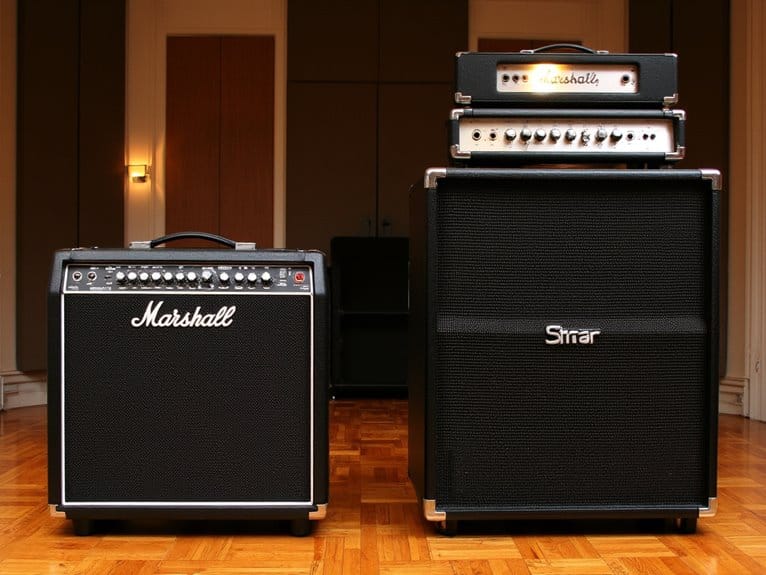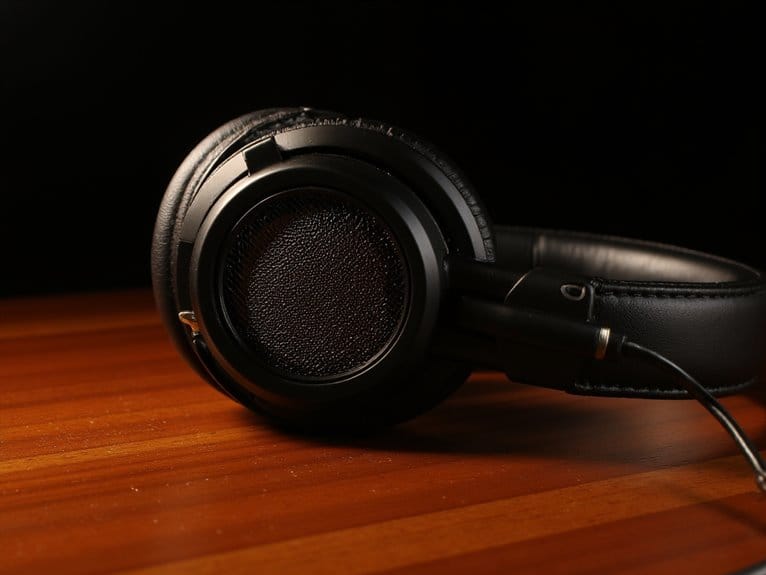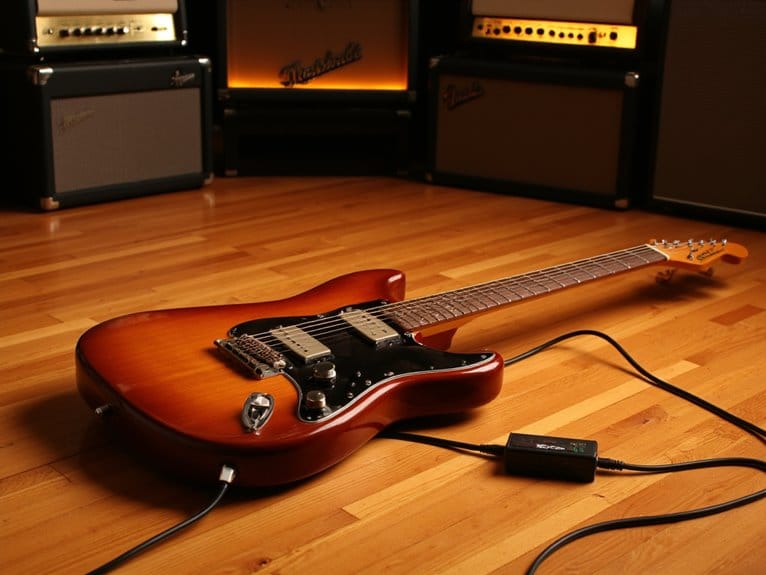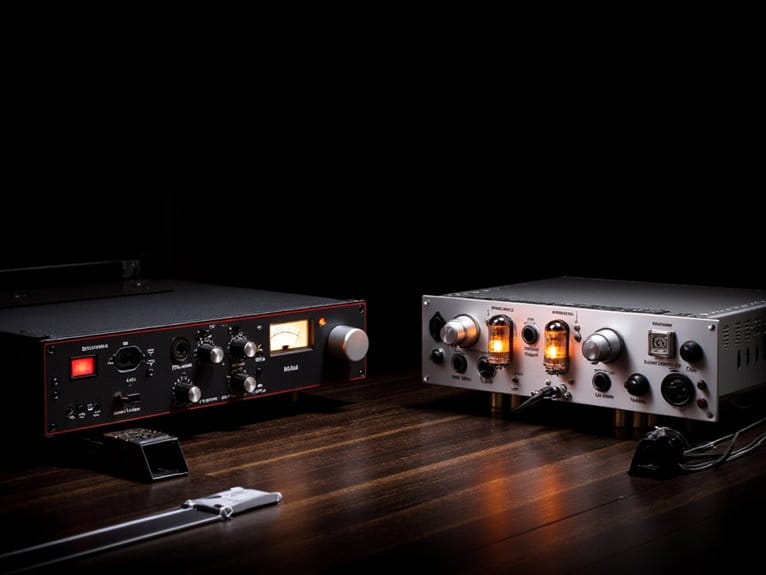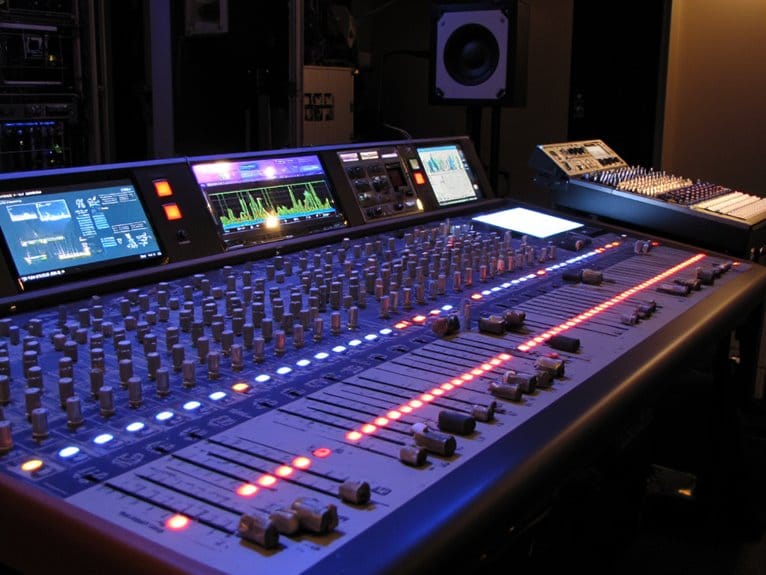Guitar Combo Amps Vs Head and Cabinet Setups
You’ll find combo amps offer plug-and-play simplicity with integrated speakers and amplifier circuits in one enclosure, though they typically weigh around 75 pounds and limit tonal customization. Head-and-cabinet setups split the weight between components, allow speaker swapping for diverse sounds, and provide mixing options between open-back and closed-back configurations, but require impedance matching knowledge and dedicated speaker cables. Your choice depends on whether you prioritize convenience or flexibility, and understanding these deeper technical considerations will help determine which configuration truly matches your performance needs.
We are supported by our audience. When you purchase through links on our site, we may earn an affiliate commission, at no extra cost for you. Learn more.
Notable Insights
- Combo amps offer plug-and-play simplicity with integrated speakers, while head/cabinet setups provide greater tonal customization through component swapping.
- Head and cabinet systems split weight between components for easier transport, whereas combo amps can be heavy but require minimal setup.
- Modular head/cab configurations allow mixing speaker types and cabinet designs, while combos provide consistent but limited tonal options.
- Jazz and blues players typically prefer combo convenience, while metal and rock guitarists favor head/cabinet flexibility for diverse sounds.
- Combo amps feature protected integrated components requiring less maintenance, while modular systems have exposed chassis needing more upkeep.
Understanding the Fundamental Differences Between Combo and Stack Systems
When I first started exploring guitar amplification, I quickly discovered that the choice between combo amps and head-and-cabinet setups represents one of the most fundamental decisions any guitarist will face, as each configuration offers distinctly different approaches to tone creation, portability, and flexibility.
Combo amps integrate everything into one enclosure, housing amplifier circuitry alongside matched speakers that manufacturers specifically voice for peak performance together.
Stack systems separate these components, requiring speaker cables to connect independent heads with external cabinets while demanding proper impedance matching between 4, 8, or 16 ohms.
This modular approach affects both sound projection characteristics and your setup preferences, since combos offer plug-and-play simplicity while stacks provide component-swapping versatility that can dramatically alter your overall sonic signature. Combo amps excel in quick rehearsals where minimal setup time and immediate playability are essential for musicians on tight schedules.
Decoupling the head from the cabinet can result in reduced microphonics compared to integrated designs, which helps minimize unwanted feedback and interference between the amplifier circuitry and speakers.
Weight Distribution and Transport Considerations for Musicians
Beyond the sonic and flexibility differences I’ve outlined, the physical realities of moving your gear around will greatly impact your day-to-day experience as a musician, particularly when you’re hauling equipment to gigs, rehearsals, or recording sessions on a regular basis.
Weight management becomes essential when you’re dealing with combo amps like the Vox AC30, which tips the scales at around 75 pounds—that’s a back-breaking single unit that’ll have you questioning your life choices on three flights of stairs.
Head and cabinet setups offer superior transport ergonomics by splitting the load between two manageable pieces, allowing you to carry each component separately and reducing injury risk while maintaining the flexibility to bring just what you need for specific venues.
Tonal Customization and Speaker Matching Capabilities
The real magic happens when you realize that speakers contribute roughly half of your guitar’s overall tone, which makes the head and cabinet approach a tonal goldmine compared to the locked-in limitations of combo amps. By choosing separate heads and cabinets, you can mix and match components to suit your personal sound preferences, allowing for greater versatility and customization. This approach not only opens up a world of tonal possibilities but also helps in identifying the best amps for clean guitar tone, ensuring that you achieve the clarity and precision you desire. Ultimately, this level of control empowers players to explore their unique sonic identity while maintaining the highest quality of sound.
You’ll discover tonal variance that’s simply impossible with fixed speaker configurations, especially when mixing different speaker sensitivity ratings.
Here’s what you can experiment with in head/cab setups:
- Open-back 2×12 cabinets dispersing warm, ambient tones throughout the room
- Closed-back 4×12 stacks delivering punchy, forward-projected aggression for rock genres
- Single 1×10 cabinets providing focused midrange clarity for studio applications
- Mixed speaker configurations combining different cone materials and sensitivities
Meanwhile, combo amps lock you into predetermined speaker characteristics, eliminating the customization possibilities that define your unique sound signature.
This flexibility becomes especially important when you consider that different guitars like Stratocasters have naturally bright, articulate voices that benefit from speaker matching to achieve the desired tonal balance. Just as lightweight construction enhances playability for young guitarists, the modular nature of head and cabinet setups reduces the physical burden of transporting heavy combo amps to different venues.
Setup Complexity and Technical Requirements
While tonal flexibility makes head and cabinet setups incredibly appealing, I’ll be honest—they come with a steeper learning curve that can intimidate guitarists who just want to plug in and play. The setup versatility of modular systems demands substantial user knowledge about impedance matching, speaker cables, and proper connections, where mistakes can lead to expensive repairs or amp failure.
| Aspect | Combo Amps | Head & Cabinet |
|---|---|---|
| Setup Time | Immediate plug-and-play | Longer due to connections |
| Technical Knowledge | Minimal requirements | Impedance matching essential |
| Cable Requirements | Standard instrument cables | Dedicated speaker cables |
| Transport Complexity | Single heavy unit | Multiple lighter pieces |
| Maintenance Needs | Integrated, protected components | Exposed chassis, higher risk |
Combo amps eliminate these technical hurdles entirely, offering straightforward operation without sacrificing quality or performance for most applications. Similarly, guitarists recording at home will find that certain audio interfaces excel at providing the plug-and-play simplicity that combo amps offer, with models like the Focusrite Scarlett Solo delivering immediate compatibility across operating systems without complex driver installations.
Sound Quality Factors and Performance Characteristics
When you’re evaluating amp configurations, sound quality becomes the ultimate deciding factor that separates good gear from great gear. I’ve found that speakers alone contribute between 33% to 50% of your overall tone—making them arguably more vital than the amplifier itself.
The interaction between preamp, power amp, and speakers creates your unique sound signature, while cabinet size dramatically affects presence and impact. Here’s what influences your sound clarity and volume dynamics:
Your sound signature emerges from the intricate dance between preamp, power amp, and speakers working in perfect harmony.
- Cathedral-sized 4×12 cabinets delivering thunderous low-end with massive stage presence
- Precision-focused 1×10 combos offering surgical accuracy for intricate playing styles
- Tube head overdrive cascading naturally through separate cabinets at concert volumes
- Factory-voiced combos providing consistent tonal balance across different venues
Head and cabinet setups offer superior headroom and less distortion at high volumes, while combos excel in predictable sound reproduction. For acoustic guitarists, dual-channel configurations enable simultaneous guitar and microphone connections, expanding your versatility beyond traditional electric setups.
While tube amplifiers provide that coveted warm, rich tone characteristic, they require more maintenance compared to their solid-state counterparts which offer greater reliability and consistency for touring musicians.
Choosing the Right Configuration for Your Playing Style and Venues
After years of hauling gear across venues ranging from cramped coffee shops to outdoor festivals, I’ve learned that matching your amp configuration to your specific playing style and venue requirements isn’t just about tone—it’s about creating a sustainable setup that supports your musical goals without breaking your back or your budget. Understanding the nuances of different amp configurations is crucial, especially when considering mobility and sound quality. A well-rounded practice guitar amps overview will help you identify the models that seamlessly blend portability and performance, ensuring you have the right tools for every gig. Ultimately, investing the time to select the ideal amp can make all the difference in delivering a polished, professional sound that captivates your audience.
Your musical genres greatly influence which configuration serves you best, with jazz and blues players often favoring combos for their plug-and-play simplicity, while metal and rock guitarists lean toward head/cab setups for maximum flexibility.
Player preferences matter equally—if you’re constantly switching between venues or need quick setup times, combos excel despite their weight limitations, whereas head/cab rigs reward those willing to invest time in proper impedance matching for superior tonal customization. The metal chassis construction and reinforced corners of quality combo amps ensure they can withstand the rigors of frequent transport between gigs.
When considering amplifier wattage, the 5-20 watt range often found in combo amps maintains excellent sound integrity for smaller venues while providing the clean tones and overdrive capabilities essential for versatile performance.
Frequently Asked Questions
Do Combo Amps Cost Less Than Equivalent Head and Cabinet Setups?
For cost comparison purposes, you’ll typically find combo amps are less expensive initially than equivalent head and cabinet setups. Budget considerations favor combos since they’re single purchases versus buying separate components that cost more combined.
Which Configuration Is Better for Home Practice and Bedroom Playing?
You’ll find combo amps better for bedroom practice due to their portability advantages and compact design. They offer excellent sound quality at lower volumes while eliminating setup complexity that head-and-cabinet configurations require.
Can I Mix Different Brand Heads With Various Speaker Cabinet Manufacturers?
You can absolutely mix different brand heads with various speaker cabinet manufacturers. Brand compatibility isn’t an issue – what matters is matching speaker impedance and power ratings between your amp head and cabinet for safe operation.
On a final note
You’ll need to weigh your priorities carefully when choosing between combo amps and head-cabinet setups. If you’re gigging regularly, combos offer simplicity and convenience, while stacks provide maximum tonal flexibility and upgrade potential. Consider your venues, transportation needs, and budget constraints. There’s no universal right answer—your playing style, musical genres, and practical requirements should guide your decision. Both configurations can deliver professional results when matched properly to your specific situation.

